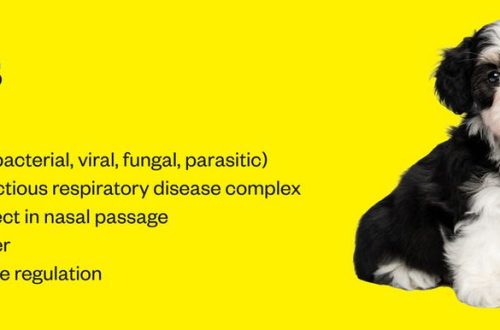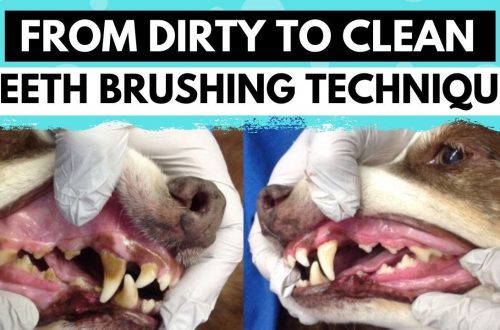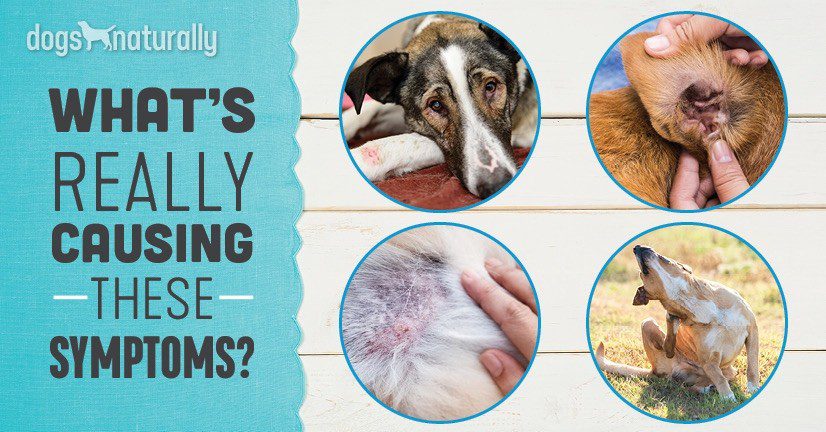
Dermatitis in dogs

Contents
Causes of the disease
As a rule, the principles of nosology are taken as the basis for classifying the nature of the disease: according to this doctrine, various disorders of the functioning of the body are combined according to signs of kinship. In this vein, experts rightly attribute dermatitis to skin diseases. Dermatitis can be infectious, inflammatory or hereditary in origin. Dermatitis can be observed in any breed of dog – both adults and puppies. stressful situations — unfavorable conditions of detention, change of owner, place of residence — can also lead to dermatitis. Often, the course of the disease is determined by several concomitant factors that must be considered when treating a pet. The defeat causes severe discomfort and causes a change in the behavior of the dog, entails various complications. Identification of dermatitis in the early stages of its development will allow you to choose a treatment that will help suppress the developing disease in the shortest possible time. Treatment of dermatitis in dogs with modern methods of disease therapy and diagnosis in most cases has a positive prognosis. But this forecast will be justified with a timely appeal to the veterinarian.
Symptoms of dermatitis in dogs
Symptoms of dermatitis in dogs can be very different, depending on the type of dermatitis and the degree of damage to the pet. The owner needs to carefully monitor the condition of the coat, since the hairline — the main indicator of health and the absence of dermatitis. The presence of dermatitis is diagnosed if the following changes in the behavior of the animal and in the condition of the skin are visually observed:
- multiple or single redness of the skin;
- hair loss;
- partial baldness;
- constant itching, licking of certain areas;
- interdigital cysts, ulcers;
- edema, emitting an unpleasant odor;
- fever, especially in inflamed areas;
- restless or, conversely, depressed state of the dog, apathy.
It happens that the owner finds redness on the skin of the pet. If the dog constantly scratches and bites the affected area, it is highly likely to assume dermatosis, since the very definition of “dermatosis” is used to refer to any diseases associated with the skin. Veterinarians rightly consider dermatitis one of the manifestations of dermatosis.
Photo of dermatitis in dogs
Photo of dermatitis in dogs
Diagnostics
Diagnosis of a particular type of dermatitis in dogs begins with a visit to a veterinary clinic. In addition to the usual examination of the general condition of the animal, the study of dermatitis includes laboratory blood tests, the diagnosis of food intolerance, taking scrapings from the affected areas of the skin, and molecular diagnostics. Last thing — a modern and accurate method that allows you to quickly identify the causal factors of the disease, even in the most difficult cases. Often, in order to exclude neoplasms, the attending veterinarian prescribes an ultrasound examination of the abdominal organs and affected areas.
To make a diagnosis and clarify the clinical picture, the veterinarian will need detailed information about the type of food, habitat, habits, previous diseases and injuries, vaccinations and drugs that the dog was treated against parasites. Do not treat the affected areas with ointments before the examination. — this can complicate the search for the cause of a particular type of dermatitis. Don’t forget to bring your veterinary passport with you!
Treatment of dermatitis in dogs
It is possible to treat dermatosis or dermatitis in various ways. The principles of treatment depend directly on the type of disease and the resistance of the dog’s body. Treatment of weeping dermatitis in dogs will differ from that of atopic dermatitis. And the treatment of atopic dermatitis is lifelong, because, unlike humans, the allergen enters the dog’s body not through the nose, but through the skin. Therefore, it is extremely difficult to remove absolutely all the irritants that cause atopic dermatitis in dogs. Food dermatitis requires a detailed analysis by a specialist: which product the dog’s body reacts to, for which feeding schemes are developed that identify the allergen. Treatment of this type can take 3-4 weeks. Parasitic dermatitis is treated faster than others, since the root cause is immediately eliminated by modern antiparasitic agents. But in any of the many types of dermatitis, you should be aware that even the healthy appearance of a pet that has received full therapy does not yet guarantee a final recovery. Dermatitis is insidious with relapses. Therefore, following all the appointments and advice of the veterinarian, it is necessary to understand that for some time the animal is shown a sparing regimen and control over the state of health.

Medication
How to treat dermatitis or dermatosis in dogs worries most caring owners. Meanwhile, therapy for the disease is differentiated and is aimed at eliminating the cause and concomitant diseases. Medical treatment usually includes antihistamines. This group is aimed at relieving swelling, itching and can be prescribed both in the form of tablets and in the form of injections.
A group of antibacterial and antifungal drugs is prescribed for recurrent dermatitis of a large affected area. This group may include both preparations for internal use, and ointments or compresses. So, bacterial dermatitis in dogs, as a rule, develops due to a secondary infection that the pet introduces by scratching or licking itself. Therefore, the main fight will be with the causative agent of secondary infection. — pathogenic microorganisms. An important detail: after a course of treatment to protect the liver of a dog, when taking antibacterial drugs, a course of hepatoprotectors helps.
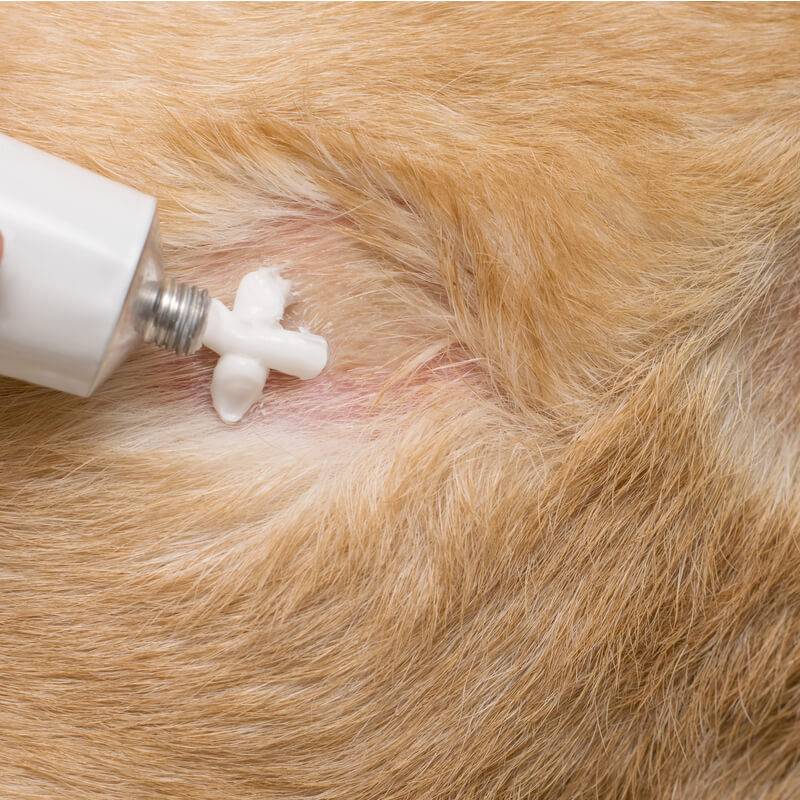
Physiotherapeutic treatment
For some types of dermatitis, including atopic dermatitis, the veterinarian may add physiotherapy support to the general treatment. In the practice of treating dermatitis, ultraviolet and infrared radiation have shown high efficiency. These procedures help to accelerate the regeneration of the skin of the animal, destroy pathogenic microflora. Against the background of physiotherapy, the immunity of the animal increases. But the best result is provided by the combined use of physiotherapy and pharmaceutical treatments. Therefore, when asked how to treat dermatitis in dogs, the veterinarian will offer to undergo a serious comprehensive examination.
Types of dermatitis in dogs
pododermatitis
Pododermatitis is characterized by damage to the limbs of the animal. The clinical picture is similar to other types of dermatitis: redness, sores, boils and swelling. In advanced cases, the foci spread to the entire surface of the body, causing baldness and profuse hair loss. In place of the affected areas of the paws, cysts and fistulas appear, complicating the healing process.
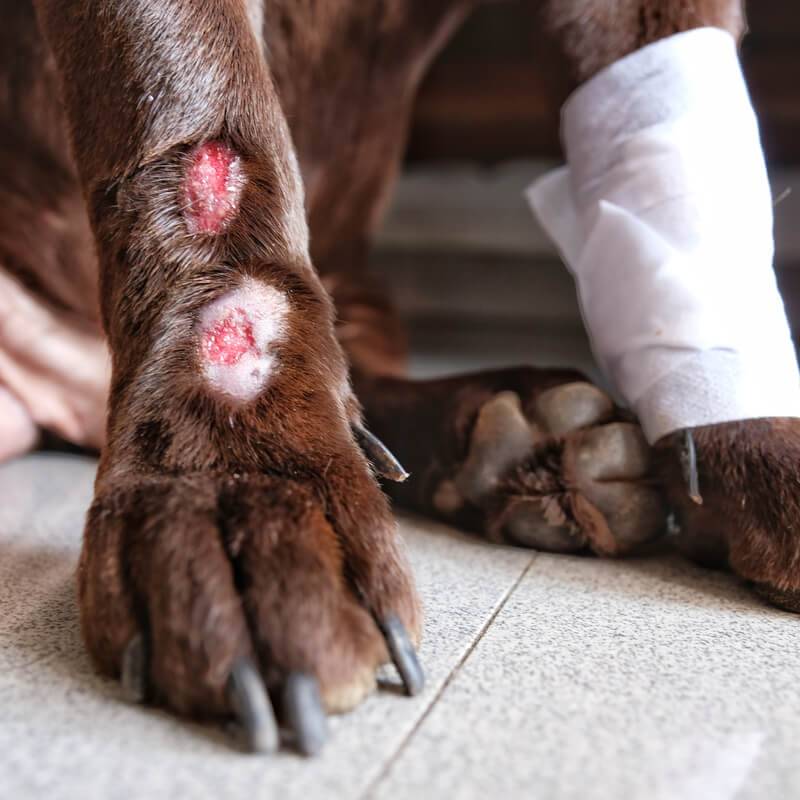
The causes of pododermatitis are different. Allocate mechanical damage to the limb (trauma). The causative agent of the disease can often be a biological nature (viruses, infections). The allergic subspecies is also quite common in the form of food intolerance to certain products or an unbalanced diet. In general, it is necessary to understand that pododermatitis is not a disease, but a symptom, since the subcutaneous mites, allergies, fungi, and even endocrine problems can be the cause of its development.
Since the disease affects the paw pads and paws of the animal, late contact with the veterinarian can lead to lameness of the dog, which will be complicated by licking of the paws. Therefore, at the stage of treatment, the veterinarian recommends purchasing a special collar at the pet store that limits the movements of the pet.
Seborrheic dermatitis
Canine seborrheic dermatitis is divided into primary and secondary. Primary is considered a genetic disease caused by a malfunction of the sebaceous glands. Secondary occurs due to metabolic problems. Both species are characterized by clinical signs: reddening of the affected areas, itching, dandruff, deterioration in the quality of the coat (the coat looks greasy, dull), and an unpleasant odor from the dog’s body.
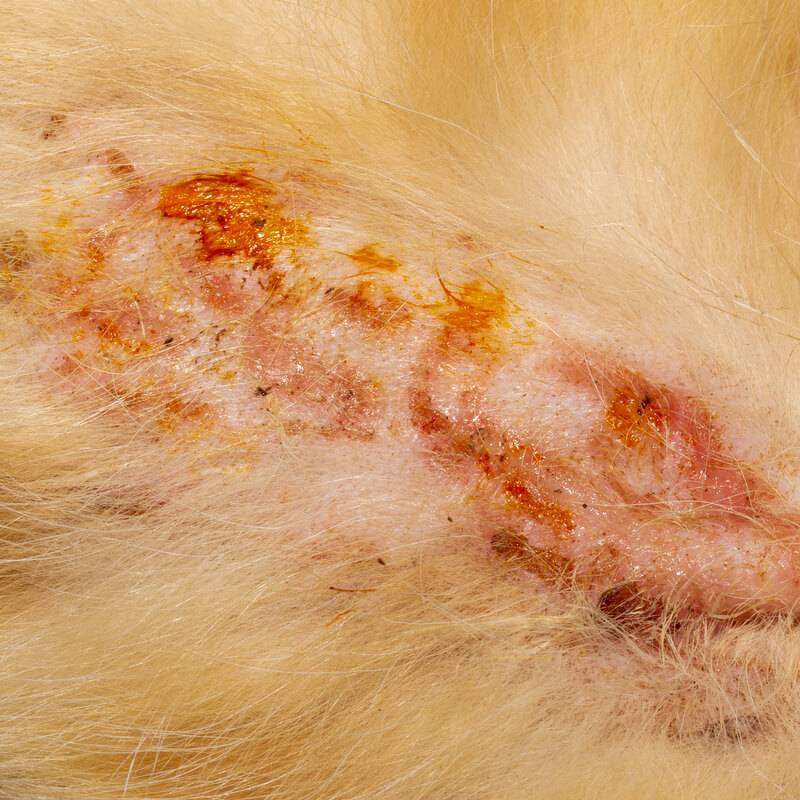
For the treatment of seborrheic dermatitis, according to veterinarian prescriptions, various modern shampoos are used, including those with tar and salicylic acid.
Acral dermatitis
This type of dermatitis occurs due to frequent licking by animals of their bodies. This behavior may be due to provoking factors: trauma, tick infestation, bacterial or fungal infections, tumor process, histiocytoma, allergies, diseases of the musculoskeletal system (joints, ligaments).
Dermatitis of this species is typical for dogs of large breeds, middle-aged and is characterized by the appearance of single dense nodules with a surface covered with small ulcers. Treatment of acral dermatitis is prescribed by a veterinarian only after stabilization of the dog’s condition caused by the underlying disease.
Pyotraumatic dermatitis
This type is also referred to as acute moist dermatitis, or hotspot. It is a self-induced traumatic acute inflammatory skin disease complicated by a secondary bacterial infection. Dogs with long hair and thick undercoat are more prone to developing piotraumatic dermatitis. Pyotraumatic dermatitis is more common in hot, humid weather.

Allergic dermatitis
Etiology of allergic dermatitis — all kinds of dog allergies. Uniting Characteristics — severe itching and, as a result, inflammation, hair loss. Depending on the causes and conditions for the occurrence of dermatitis, short-term and chronic cases are distinguished. Treatment of allergic dermatitis in dogs depends on the specific, specific clinical presentation of the manifestation, depending on which the veterinarian will select the appropriate treatment. One type of allergic dermatitis — contact dermatitis in dogs. The provocateur of this type of dermatosis is household chemicals or cosmetics for animals, and pets kept in apartments usually get sick with it.
Atopic dermatitis
Atopic dermatitis is a genetic pathology. Development can begin at 4-6 months of age in puppies and recur until three or more years of age. Pathology is characterized by a variety of skin rashes, constant dryness of the integument, their thickening and various damage to the dog’s skin. — from ordinary wounds to eczema. With proper treatment and care, remission is observed, but a complete cure is impossible. Therefore, the main direction of treatment of atopic dermatitis — control symptoms and reduce the frequency of exacerbations in the dog. The veterinarian identifies the provoking factor on the basis of specially designed tests.
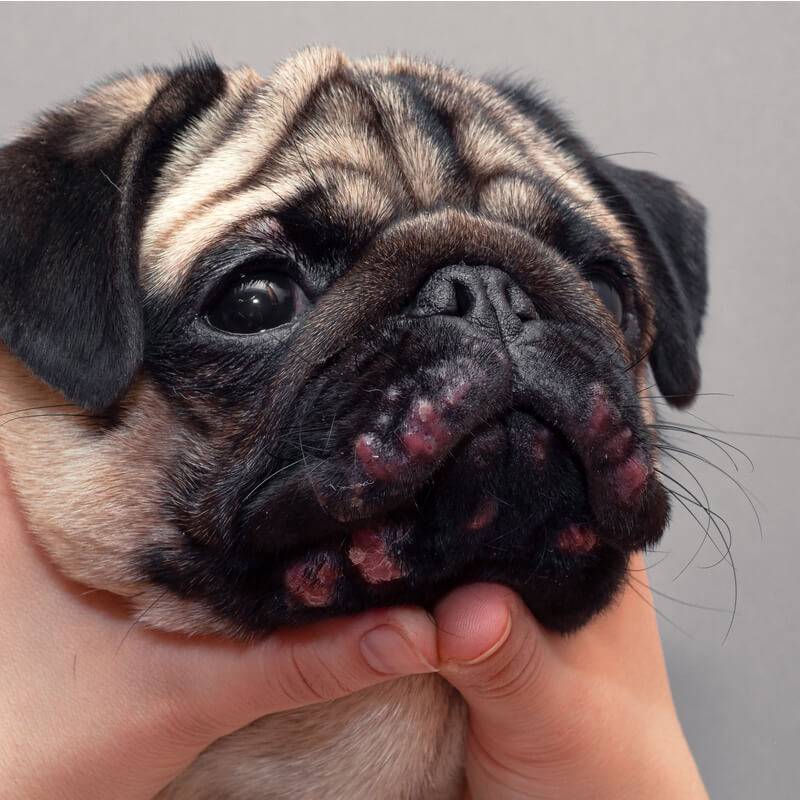
Flea dermatitis
Flea dermatitis occurs as a result of a pet’s reaction to any parasites and blood-sucking, including infection with helminths. Depending on the pathogen, separate types of dermatitis are distinguished, which can be combined on the basis of the relationship of pathogens. For example, the tick form is provoked by both subcutaneous and external parasites. Depending on the body’s resistance, flea dermatitis can occur in milder or more severe forms. The disease directly depends on the degree of skin sensitivity, individual susceptibility to saliva, waste products, bites, the appearance of subcutaneous passages of parasites and blood-sucking insects.
With flea dermatitis, the formation of severely itchy papules is observed; traces of scratching, especially noticeable in places with delicate skin (in the groin, under the arms, on the face), redness of the skin, hyperpigmentation of the integument in the sacrum, abdomen, lower back, as well as alopecia.

Ear mite
Diagnosed by visual detection of parasites. To cure, it is necessary to conduct a thorough treatment of the dog. In the early stages of the disease, it is enough to purchase special drops, shampoos or preparations against parasites at the pet store. The place of the dog in the apartment or house should be treated with a special compound that excludes the appearance of fleas or ticks. — these products can also be purchased at the pet store.
Flea dermatitis in a puppy is more common than in an adult dog. This is due to the fact that the skin of puppies is still very delicate, and parasite bites can severely injure it, causing itching.
How to prevent disease
For the prevention of dermatitis of any type, it is important:
- observe the schedule for treating the dog from parasites, write down the dates of treatment in the animal’s passport;
- provide a balanced diet, pay attention to the chair;
- carefully examine the pet for injuries, irritations, rashes;
- carefully inspect the paws after each walk, use special ointments in winter or wear shoes that protect the paws;
- when washing a dog, pay attention to the space between the fingers of the pet: dirt should not accumulate here;
- use special shampoos with antipruritic and anti-inflammatory effects;
- choose comfortable collars and harnesses that are suitable for the size of the dog;
- upon detection of injuries, immediately decontaminate the damaged area;
- do not self-medicate without examining the pet by a veterinarian;
- in warm and hot seasons, give your pet a haircut.
The article is not a call to action!
For a more detailed study of the problem, we recommend contacting a specialist.
Ask the vet
15 2020 June
Updated: 22 May 2022




